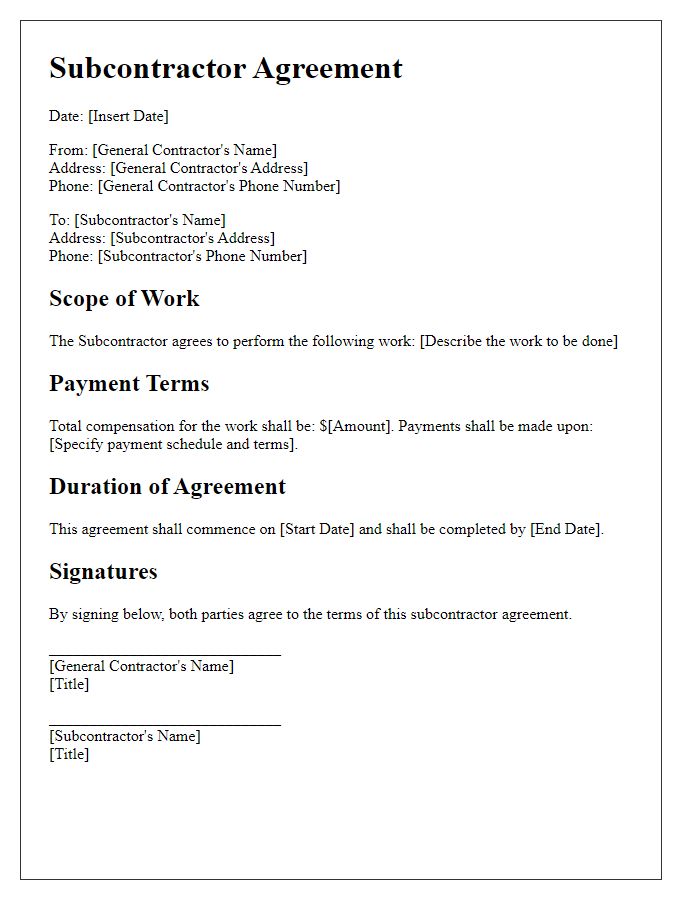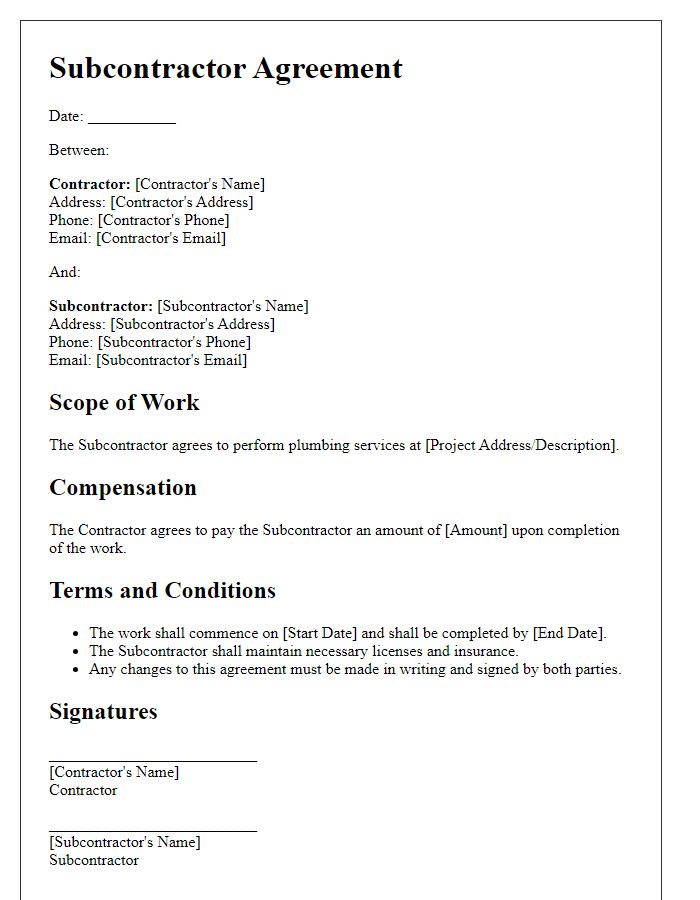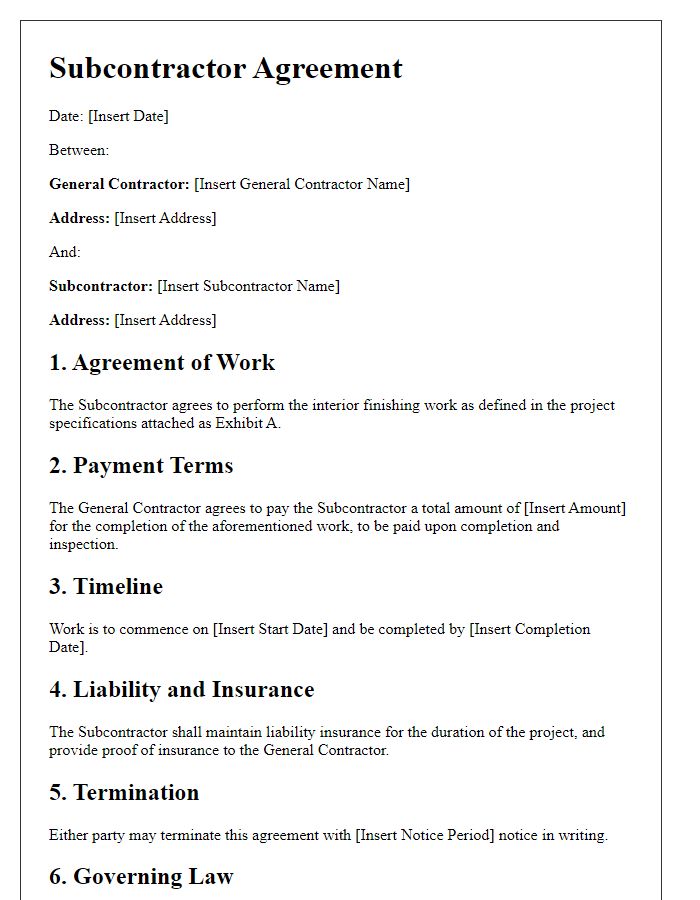Are you navigating the complexities of a construction subcontract agreement? Crafting a clear and comprehensive letter template is essential for ensuring that all parties understand their responsibilities and expectations. This guide will walk you through the key elements to include, making the process smoother and more efficient. Let's dive in and explore how you can create a robust subcontract agreement that protects everyone involved.

Clear Project Scope
A well-defined project scope is crucial for construction subcontract agreements, detailing the specific tasks and responsibilities assigned to subcontractors. Key elements include the nature of work, such as electrical installations, plumbing fittings, or masonry, along with project milestones, timelines, and deliverable specifications. Clear definitions of responsibilities help prevent disputes regarding quality of work and safety compliance, especially in high-stakes environments like commercial buildings or residential renovations. Additionally, incorporating local building codes, regulatory requirements, and site access guidelines ensures all parties understand their obligations. This clarity supports effective communication and coordination among general contractors, subcontractors, and suppliers throughout the project's lifecycle.
Payment Terms
Payment terms in a construction subcontract agreement outline the conditions under which payments will be made to subcontractors for their services. Payment schedules typically include milestones such as the completion of specific phases of work, which can be defined by percentages (often in increments of 10% or 20%) tied to project progression. Payment methods, whether through electronic transfer or checks, should be specified alongside required documentation, such as invoices and lien waivers, to ensure legal compliance and protect all parties involved. Additionally, late payment penalties, often calculated as a percentage of the outstanding amount per month, can be included to encourage timely settlements. The stipulation of retainage, commonly 5% to 10%, held until project completion, provides a financial incentive for subcontractors to fulfill their contractual obligations. Clear communication regarding modifications in work scope, potentially impacting financial agreements, should also be explicitly stated to prevent disputes.
Health and Safety Regulations
Construction subcontract agreements must strictly adhere to Health and Safety Regulations mandated by local government entities, such as the Occupational Safety and Health Administration (OSHA) in the United States. Compliance with these regulations is essential to prevent workplace accidents and ensure a safe working environment for all personnel on site, particularly in high-risk activities such as scaffolding and excavation. Furthermore, regular safety training sessions for subcontractors are crucial, addressing potential hazards associated with construction work, which may include heavy machinery operation and exposure to hazardous materials like asbestos or lead paint. In addition, appropriate personal protective equipment (PPE), such as hard hats, gloves, and safety goggles, must be provided and utilized by all workers to minimize injury risks. Adhering to these regulations not only promotes the well-being of employees but also protects the integrity and credibility of the contracting firm within the construction industry.
Work Schedule
A construction subcontract agreement outlines the work schedule for subcontractors involved in a particular project, such as the construction of a commercial building located in downtown Los Angeles. This schedule typically details the start date, September 1, 2023, and completion date, December 15, 2023, emphasizing critical phases like foundation pouring and frame erection that must align with the overall project timeline. Moreover, it specifies daily work hours from 7 AM to 5 PM, including weekends if needed for expedited timelines. Furthermore, provisions for potential delays due to weather, permits, or supply chain disruptions are included, ensuring all parties remain informed about possible adjustments to the overall schedule. Each subcontractor's specific deliverables, such as electrical installations by ABC Electrical Services or plumbing by XYZ Plumbing, are highlighted, ensuring organized coordination on-site in adherence to safety and quality standards.
Dispute Resolution Clause
Dispute resolution clauses in construction subcontract agreements are essential for addressing conflicts that may arise during project execution. These clauses typically outline methods for resolving disputes, such as mediation or arbitration, rather than litigation. For example, in a Florida-based construction project, parties may agree to submit disputes to a mediator certified by the Florida Supreme Court for resolution before escalating them to arbitration. The American Arbitration Association may be selected as the arbitration body, with proceedings governed by the Construction Industry Arbitration Rules. A stated timeline for initiating mediation could range from 30 to 60 days after notifying the other party of a dispute, ensuring timely resolution. Additionally, the clause may specify that both parties share the costs of mediation or arbitration equally, promoting cooperation. Effective dispute resolution clauses help maintain positive working relationships and prevent costly project delays.
Letter Template For Construction Subcontract Agreement Samples
Letter template of subcontractor agreement for residential construction.

Letter template of subcontractor agreement for commercial building projects.

Letter template of subcontractor agreement for general contractor services.











Comments